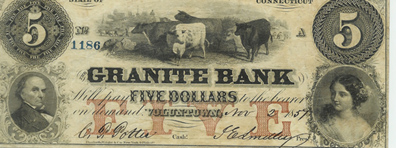 |
Home |
 |
History |
 |
Meetings |
 |
Articles |
 |
Book Reviews |
 |
Annual Coin Show |
 |
Join |
 |
Links |
 |
Contact us |
A WILDCAT BANKNOTE
“Wildcat Banking” was a term used frequently during the early and mid-1800’s. It referred to the unscrupulous banking practices of some of these institutions. During their day the banks were the prime source of paper currency. The Federal Government did not issue paper until 1863.
Most bankers kept a tight ship in regard to their business practices and reputation. After all they wanted us all to “bank on it”. Some however saw banking as an opportunity to float some paper in hopes it never returned for redemption. Paper money issues back then were not backed by “hard money” but rather the integrity of the bank itself. Because many of the fraudulent banks were located in out of the way places and often deep in the wilderness their paper money became known as Wildcat Banknotes.

The note shown above is an example of an issue from one such organization here in Connecticut. The Granite Bank of Voluntown was a fraud from the outset. The notes of this “bank” were issued from a saloon in New York City as change for bills of larger denominations.
Many months, perhaps more than a year, passed before the bank inspectors came to realize there was no such institution in Voluntown at all! By then quite a bit of this worthless money reached circulation at some profit to the perpetrators. Today this “worthless” paper commands a premium from collectors.
A bill such as the one seen here, in mediocre condition (collectors would call this condition VERY FINE) would sell in the range of $50-100.